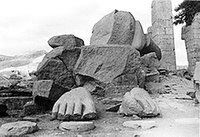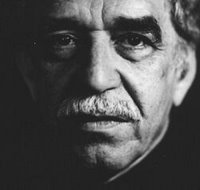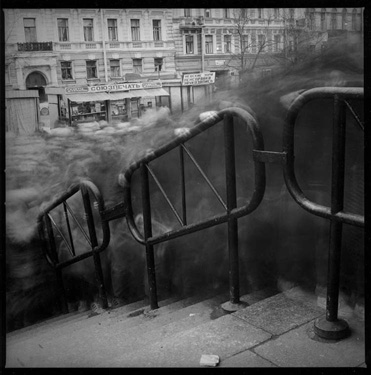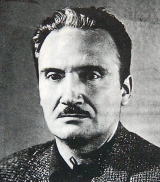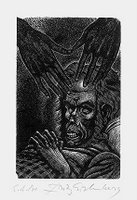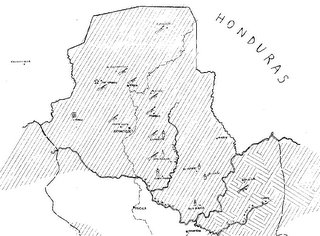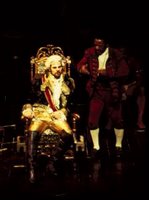
A brief note in the July 2003 edition of
The American Journal of Psychiatry, entitled
"Delusional Self-Portrait", concerns the case of "Mr A, a 32-year old Caucasian man" who had asked
to have some wires that stopped him from sleeping removed from his leg. He said there were many more wires inside his body that he had discovered after experiencing that "a magnetism of storms" produced multiple internal sensations in the form of erratic contractions and "electric currents," which he tried to alleviate by sticking needles into himself so as to "discharge the current by touching the wires with a metallic object."
Mr A depicted his condition by means a stick figure, made of wire, which he had taped to the cover of his diary: "That’s what I’m like inside—all made of metal."
The psychiatrists treating him diagnose "cenesthetic schizophrenia," a condition characterized by "a peculiar conservation of affectivity." Chambers defines cenesthesis (also, coenaesthesis) as "general consciousness or awareness of one's body." Webster defines it as "common sensation or general sensibility." It is, in short, affect without specific object. It is affect in common, affect
as such; an unspecific but decidedly concrete consciousness of materiality.
It is not then so surprising that the treatment prescribed for Mr A should have been markedly literary: the point was presumably to (re-)enable representation, to give this non-specific affect subject and object. So the patient was recommended to read Miguel de Cervantes's "El licenciado Vidriera" ("The Glass Graduate"). Upon reading Cervantes's short story, we are told, Mr A gained a measure of relief:
I was relieved that somebody else had experienced the same as me, and I realized that reality is a very broad, diverse concept, not something unique and the same for everybody.
This Golden Age "exemplary novel" thus proves its exemplarity: providing both a literary precursor against which experience can be (re-)cast as similar, a repetition; and also ironically modelling singularity, that is the unrepeatable, itself. The singular becomes representable only through its iteration, its doubling.
We have something here of what Jacques Derrida, in
Monolingualism of the Other, terms "the exemplary or testimonial singularity of
martyred existence" (27; emphasis in original). Cervantes becomes a proleptic witness to Mr A's pain. And Derrida is precisely interested in this establishment of representation by means of the paradoxical meeting of the singular (an unrepresentable affect, a pain no-one else can feel) and the universal (a sign system available to all):
As regards so enigmatic a value as that of attestation, or even of exemplarity in testimony, here is a first question, the most general one, without the shadow of a doubt. What happens when someone resorts to describing an allegedly uncommon situation [. . .] by testifying to it in terms that go beyond it, in a language whose generality takes on a value that is in some way structural, universal, transcendental, or ontological? When anybody who happens by infers the following: "What holds for me, irreplaceably, also applies to all. [. . .]" (19-20)
The only twists here are, first, the pre-emptive character of Cervantes's exemplarity--a "classic" written almost 400 years ago--and second, the analytic scene. But this is precisely how analysis works: transforming immanence into a relation with transcendence through representation, by provoking identification and recognition on the part of the analysand: the conjunctive synthesis, "so
that's what it was!" (Deleuze and Guattari,
Anti-Oedipus 20).

That moment of realization is, of course, the fruit of interpretation. In his Prologue to the
Exemplary Novels Cervantes underlines, albeit circuitously and somewhat ironically, the ways in which they demand readerly hermeneutics:
I have called them Exemplary, and if you look closely, you will see that there is not one from which you cannot extract some profitable example; and if it were not for the fact that it would make this over-long, perhaps I would show you the delicious and wholesome fruit which could be pulled both from the collection as a whole and from each one alone.
He is not going to
show us the moral to be gleaned from his writing, precisely because a large part of that moral--perhaps
the moral--is the requirement to "look closely" and to decipher the texts' meanings, apparently for yourself (your
self?).
The story prescribed to treat Mr A, "The Glass Graduate," is in many ways an allegory of interpretation: it deals with clarity and obscurity, and, equally, the difficulties of knowing either the self or the other.
Very briefly, the plot concerns a boy, who initially adopts the name Tomás Rodaja and is in turn adopted by two "gentleman students" from Málaga and sponsored through the course of studies in law at Salamanca. He subsequently takes up with a Captain of the army, and tours Italy before going on to Flanders. Returning to Salamanca, he is poisoned by an ardent suitor, as result of which
The unfortunate young man imagined that he was all made of glass, and in this delusion, whenever anyone approached him, he would shriek, begging and pleading with coherent words and arguments, for people not to come near, because they would break him, because really and truly he was not as other men--he was made of glass from head to foot. (73)
Taking as his name the Glass Graduate, or just Glass, in his madness the youth wanders the streets delivering caustic aphorisms on contemporary social mores, and as such becomes something of a character and celebrity. After two years as a semi-itinerant holy fool, sleeping and travelling packed in hay to ensure that his fragile body is well protected, he is rather abruptly cured by a Hieronymite friar. But, as a notorious former madman, he is unable to return to the practice of law, so with the name now of Tomás Rueda he sets off instead to seek fame in arms in the company of his friend Captain Valdivia.
The graduate's sense of self is shown to be brittle in a host of aspects. As I've indicated, he's forever changing both his social role and his name: there's more than a little of the picaresque about his adventures, except that he is for all intents and purposes without character; he is instead consistently renamed and re-adopted by those around him. We learn next to nothing about his background, and never, for instance, learn his real name (if indeed he has one). Until his final (un-narrated) incarnation as valiant soldier, he is notably shy to commit or invest in anything or anyone. (Elaine Dunn's
"Fashioning Identities in 'El licenciado Vidriera'" is good on the ways in which he "resists all forms of intimacy and social relations" [130].)
He never really acquires an ego, then: he serves rather as a lens through which others are led to believe they see the hypocrisy and corruption of their own society all the clearer. In this sense, he's not far wrong to imagine himself as made out of glass. (Indeed, as George Shipley implies in
"Vidriera's Blather", perhaps that's about the sum total of what he's not wrong about.)
But at least he is of interest. For all the desire for a cure, or for all that this like the other exemplary novels is designed to be curative, in the end the normalized subject is, frankly, portrayed as rather boring. In fact, he's not portrayed at all, but is dispensed with in a final, single sentence, paragraph. When the exemplary becomes universal, it no longer holds any pull on narrative; it has simply flattened out into language as such. It is only in so far as the exemplary remains singular, and so resists representation, that it also demands narrativization, even if that narrative ultimately irons out and eliminates the very singularity that is at first so seductive.
The same is true, for instance, of the eponymous "Jealous Old Man from Extremadura." As soon, at the tale's resolution, as he comes to his senses and gives up his jealousy, he is promptly dispatched without further ado, expiring within seven days and a single sentence. (On a rather different tack, I heartily recommend Shirfa Armon's analysis of this story in
"The Paper Key", which persuasively argues that it is a critique of Spain's unprofitable investment of American spoils, and an anticipation of the shift from faith in precious ore to the fluidity of paper money.)
Finally, though, is there not another way of thinking about creatures of glass? One outlined in a poem by Keith Walton that also takes the title
"The Glass Graduate". This gives us a voice whose glass self is not distanced and packaged away from the world, but vibrantly expectant and affectively, joyously, erotically responsive to the slightest liquid touch:
I sing
as the wetted finger
circles my rim
vibrate
wait
terrified -
Sing! Sing! Sing!
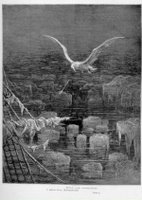 Meanwhile, traditional literary criticism has also understood the symbolic to be a form of repetition or reiteration. A symbol is an instance of double voicing: where a given word or thing signifies on two (or more) registers. Thus to say that, for example, the albatross in Coleridge's "Rime of the Ancient Mariner" functions as a symbol, is to say that the bird is more than it first appears: not only is it an element within the ostensible plot; it also carries with it broader connotations. So when the mariner kills the bird, he kills more than just a feathered beast.
Meanwhile, traditional literary criticism has also understood the symbolic to be a form of repetition or reiteration. A symbol is an instance of double voicing: where a given word or thing signifies on two (or more) registers. Thus to say that, for example, the albatross in Coleridge's "Rime of the Ancient Mariner" functions as a symbol, is to say that the bird is more than it first appears: not only is it an element within the ostensible plot; it also carries with it broader connotations. So when the mariner kills the bird, he kills more than just a feathered beast.